child restraint FIAT FIORINO 2019 Owner handbook (in English)
[x] Cancel search | Manufacturer: FIAT, Model Year: 2019, Model line: FIORINO, Model: FIAT FIORINO 2019Pages: 220, PDF Size: 6.22 MB
Page 73 of 220
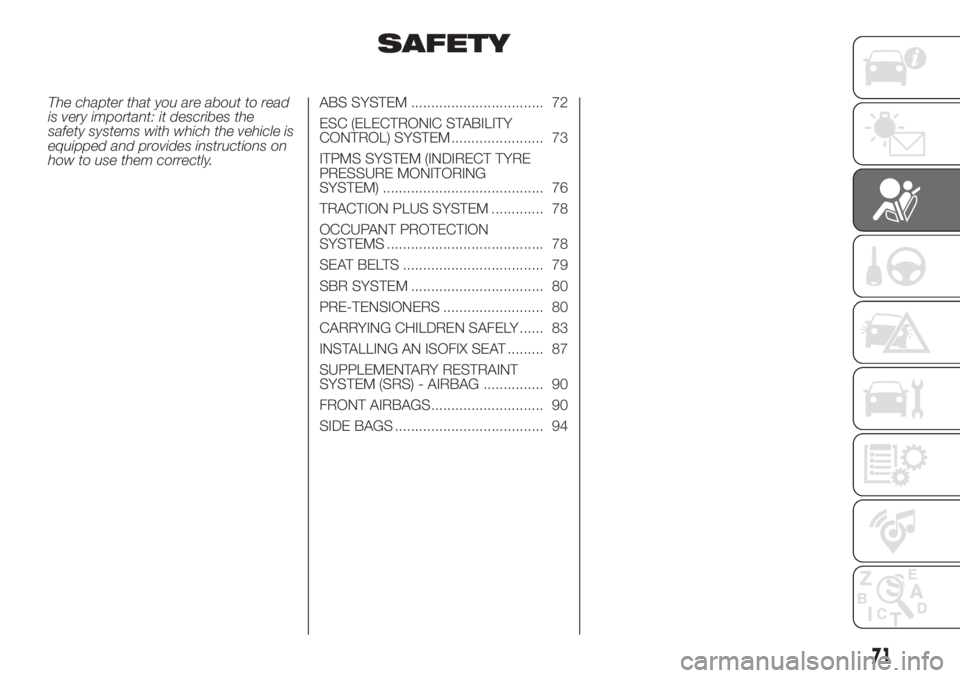
SAFETY
The chapter that you are about to read
is very important: it describes the
safety systems with which the vehicle is
equipped and provides instructions on
how to use them correctly.ABS SYSTEM ................................. 72
ESC (ELECTRONIC STABILITY
CONTROL) SYSTEM ....................... 73
ITPMS SYSTEM (INDIRECT TYRE
PRESSURE MONITORING
SYSTEM) ........................................ 76
TRACTION PLUS SYSTEM ............. 78
OCCUPANT PROTECTION
SYSTEMS ....................................... 78
SEAT BELTS ................................... 79
SBR SYSTEM ................................. 80
PRE-TENSIONERS ......................... 80
CARRYING CHILDREN SAFELY ...... 83
INSTALLING AN ISOFIX SEAT ......... 87
SUPPLEMENTARY RESTRAINT
SYSTEM (SRS) - AIRBAG ............... 90
FRONT AIRBAGS............................ 90
SIDE BAGS ..................................... 94
71
Page 80 of 220
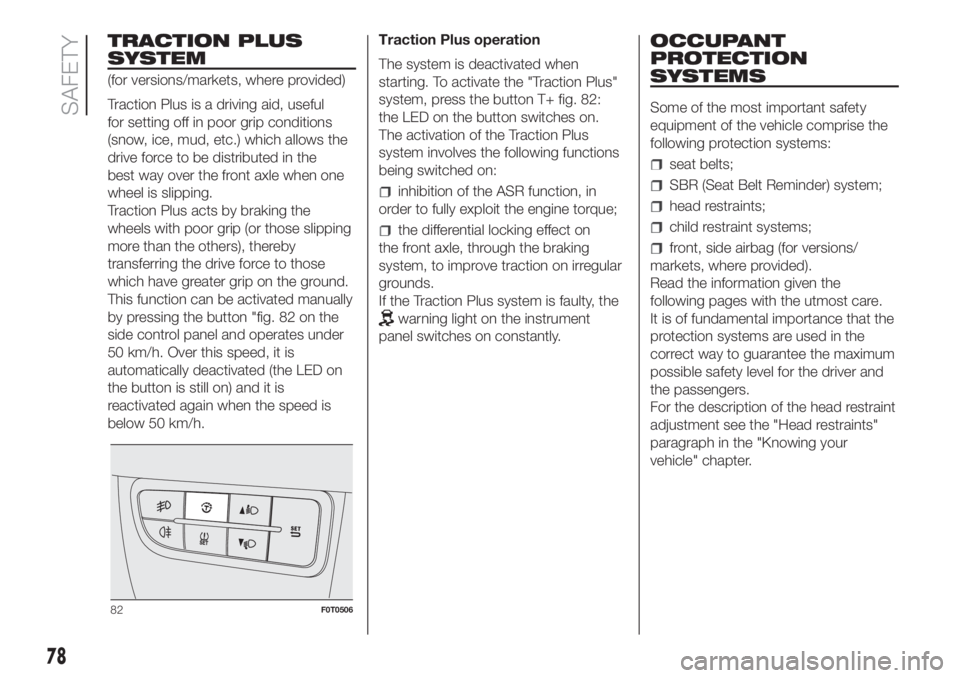
TRACTION PLUS
SYSTEM
(for versions/markets, where provided)
Traction Plus is a driving aid, useful
for setting off in poor grip conditions
(snow, ice, mud, etc.) which allows the
drive force to be distributed in the
best way over the front axle when one
wheel is slipping.
Traction Plus acts by braking the
wheels with poor grip (or those slipping
more than the others), thereby
transferring the drive force to those
which have greater grip on the ground.
This function can be activated manually
by pressing the button "fig. 82 on the
side control panel and operates under
50 km/h. Over this speed, it is
automatically deactivated (the LED on
the button is still on) and it is
reactivated again when the speed is
below 50 km/h.Traction Plus operation
The system is deactivated when
starting. To activate the "Traction Plus"
system, press the button T+ fig. 82:
the LED on the button switches on.
The activation of the Traction Plus
system involves the following functions
being switched on:
inhibition of the ASR function, in
order to fully exploit the engine torque;
the differential locking effect on
the front axle, through the braking
system, to improve traction on irregular
grounds.
If the Traction Plus system is faulty, the
warning light on the instrument
panel switches on constantly.
OCCUPANT
PROTECTION
SYSTEMS
Some of the most important safety
equipment of the vehicle comprise the
following protection systems:
seat belts;
SBR (Seat Belt Reminder) system;
head restraints;
child restraint systems;
front, side airbag (for versions/
markets, where provided).
Read the information given the
following pages with the utmost care.
It is of fundamental importance that the
protection systems are used in the
correct way to guarantee the maximum
possible safety level for the driver and
the passengers.
For the description of the head restraint
adjustment see the "Head restraints"
paragraph in the "Knowing your
vehicle" chapter.
82F0T0506
78
SAFETY
Page 85 of 220

CARRYING
CHILDREN SAFELY
For optimal protection in the event of an
impact, all occupants must be seated
and wearing adequate restraint
systems, including newborn and other
children!
This prescription is compulsory in all EC
countries according to EC Directive
2003/20/EC.
Children below the height of 1.50
metres and up to 12 years must be
protected with suitable restraint
systems and be seated on the rear
seats. Statistics on accidents indicate
that the rear seats offer greater safety
for children.
Compared with an adult, a child's head
is larger and heavier in proportion to
their body and the child's muscular and
bone structures are not fully developed.
Therefore, correct restraint systems
other than adult seat belts are
necessary to reduce as much as
possible the risk of injuries in the event
of an accident, braking or a sudden
manoeuvre.Children must be seated safely and
comfortably. As far as the
characteristics of the child seats used
allow, you are advised to keep children
in rear facing child seats for as long
as possible (at least until 3–4 years old),
since this is the most protected
position in the event of an impact.
It is recommended to always choose
the restraint system most suitable
for the child; for this reason always refer
to the Owner Handbook provided with
the child restraint system, to be sure
that it is of the right type for the children
it is intended for.
In Europe the characteristics of child
restraint systems are ruled by the
regulation ECE-R44, dividing them into
five weight groups:
Group Weight range
Group 0up to 10 kg in
weight
Group 0+up to 13 kg in
weight
Group 1 9-18 kg
Group 2 15-25 kg
Group 3 22-36 kg
All restraint devices must bear the
type-approval data, together with the
control mark, on a label solidly fixed to
the child restraint system which must
never be removed.
Lineaccessori Fiat offers child restraint
systems for each weight group. These
devices are recommended, having
been specifically designed for Fiat cars.
IMPORTANT For correct installation
on the car, some universal child
restraint systems require an accessory
(base) sold separately by the restraint
system's producer. Therefore, FCA
advises customers to check that their
chosen child restraint system can
be installed on their vehicle by
performing a trial installation, on the
vendor's premises, before purchase.
73) 74) 75) 76)
INSTALLING A CHILD
CARSEAT WITH
SEATBELTS
77) 78) 79) 80) 81)
GROUP 0 and 0+
Babies up to 13 kg must be carried
with a rear facing child restraint system
of a type as shown in fig. 90 which,
supporting the head, does not induce
stress on the neck in the event of
sudden decelerations.
83
Page 86 of 220

The rear facing child restraint system is
restrained by the vehicle seat belts,
as shown in fig. 90 and it must restrain
the child in turn with its own belts.
GROUP 1
Children weighing from 9 to 18 kg may
be transported in forward facing child
restraint systems fig. 91.GROUP 2
Children from 15 to 25 kg may use the
vehicle seat belts directly fig. 92.
In this case, the child restraint system is
used to position the child correctly
with respect to the seat belts so that
the diagonal belt section crosses the
child’s chest and not the neck, and the
lower part is snug on the pelvis not
the abdomen.
GROUP 3
For children between 22 and 36 kg,
there are dedicated restraint systems
that allow the seat belt to be worn
correctly.
The fig. 93 shows the correct child
positioning on the rear seat.
Children over 1.50 m in height can wear
seat belts like adults.
90F0T0006
91F0T0007
92F0T0008
93F0T0009
84
SAFETY
Page 87 of 220

SUITABILITY OF PASSENGER SEATS FOR THE USE OF CHILD RESTRAINT
SYSTEMS
The vehicles designed to carry people (homologation M1) comply with the new European Directive 2000/3/EC which governs
the arrangement possibilities for child restraint systems on the seats of the vehicle as shown in the following table:
Group Weight range Front passenger Rear passenger
Airbag enabled Airbag deactivated
Group 0, 0+ up to 13 kgXUU
Group 1 9 - 18 kgXUU
Group 2 15 - 25 kgUUU
Group 3 22–36 kgUUU
X Seat not suitable for children in this weight category.
U suitable for child restraint systems in the "Universal" category, according to European Standard ECE-R44 for the specified "Groups".
WARNING
73)SERIOUS DANGER: When an active passenger airbag is fitted, DO NOT install rear facing child restraint systems on the front seat.
Deployment of the airbag in an accident could cause fatal injuries to the child regardless of the severity of the impact. It is advisable to always
carry children in a child restraint system on the rear seat, which is the most protected position in the event of a collision.
74)Should it be necessary to carry a child on the passenger side front seat in a rearward-facing child restraint system, the passenger side
front airbag and side bag (for versions/markets, where provided) must be deactivated through the Setup menu. Deactivation should be
verified by checking whether the
warning light is switched on in the central dashboard. Move the passenger's seat as far back as possible
to avoid contact between the child seat and the dashboard.
75)On the sun visor there is a label with suitable symbols reminding the user that it is compulsory to deactivate the airbag if a rearward facing
child restraint system is fitted. Always comply with the instructions on the passenger side sun visor (see the "Supplementary Restraint
System (SRS) - Airbag" paragraph).
76)Do not move the front or rear seat if a child is seated on it or on the dedicated child restraint system.
77)Incorrect fitting of the child restraint system may result in an inefficient protection system. In the event of an accident the child restraint
system may become loose and the child may be injured, even fatally. When fitting a restraint system for newborns or children, strictly comply
with the instructions provided by the Manufacturer.
85
Page 88 of 220
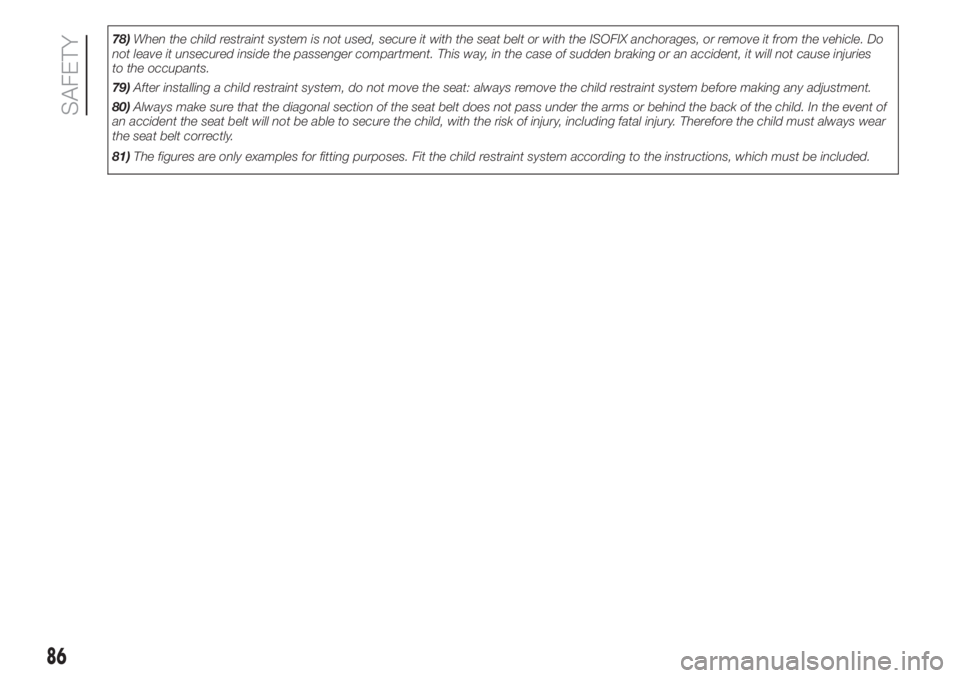
78)When the child restraint system is not used, secure it with the seat belt or with the ISOFIX anchorages, or remove it from the vehicle. Do
not leave it unsecured inside the passenger compartment. This way, in the case of sudden braking or an accident, it will not cause injuries
to the occupants.
79)After installing a child restraint system, do not move the seat: always remove the child restraint system before making any adjustment.
80)Always make sure that the diagonal section of the seat belt does not pass under the arms or behind the back of the child. In the event of
an accident the seat belt will not be able to secure the child, with the risk of injury, including fatal injury. Therefore the child must always wear
the seat belt correctly.
81)The figures are only examples for fitting purposes. Fit the child restraint system according to the instructions, which must be included.
86
SAFETY
Page 89 of 220
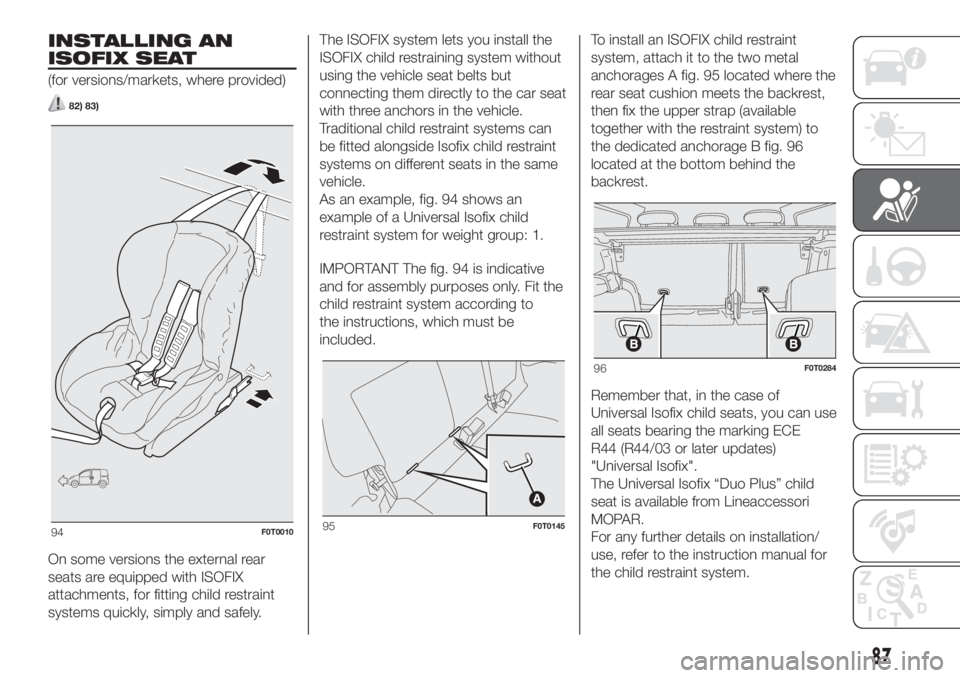
INSTALLING AN
ISOFIX SEAT
(for versions/markets, where provided)
82) 83)
On some versions the external rear
seats are equipped with ISOFIX
attachments, for fitting child restraint
systems quickly, simply and safely.The ISOFIX system lets you install the
ISOFIX child restraining system without
using the vehicle seat belts but
connecting them directly to the car seat
with three anchors in the vehicle.
Traditional child restraint systems can
be fitted alongside Isofix child restraint
systems on different seats in the same
vehicle.
As an example, fig. 94 shows an
example of a Universal Isofix child
restraint system for weight group: 1.
IMPORTANT The fig. 94 is indicative
and for assembly purposes only. Fit the
child restraint system according to
the instructions, which must be
included.To install an ISOFIX child restraint
system, attach it to the two metal
anchorages A fig. 95 located where the
rear seat cushion meets the backrest,
then fix the upper strap (available
together with the restraint system) to
the dedicated anchorage B fig. 96
located at the bottom behind the
backrest.
Remember that, in the case of
Universal Isofix child seats, you can use
all seats bearing the marking ECE
R44 (R44/03 or later updates)
"Universal Isofix".
The Universal Isofix “Duo Plus” child
seat is available from Lineaccessori
MOPAR.
For any further details on installation/
use, refer to the instruction manual for
the child restraint system.
94F0T001095F0T0145
96F0T0284
87
Page 90 of 220
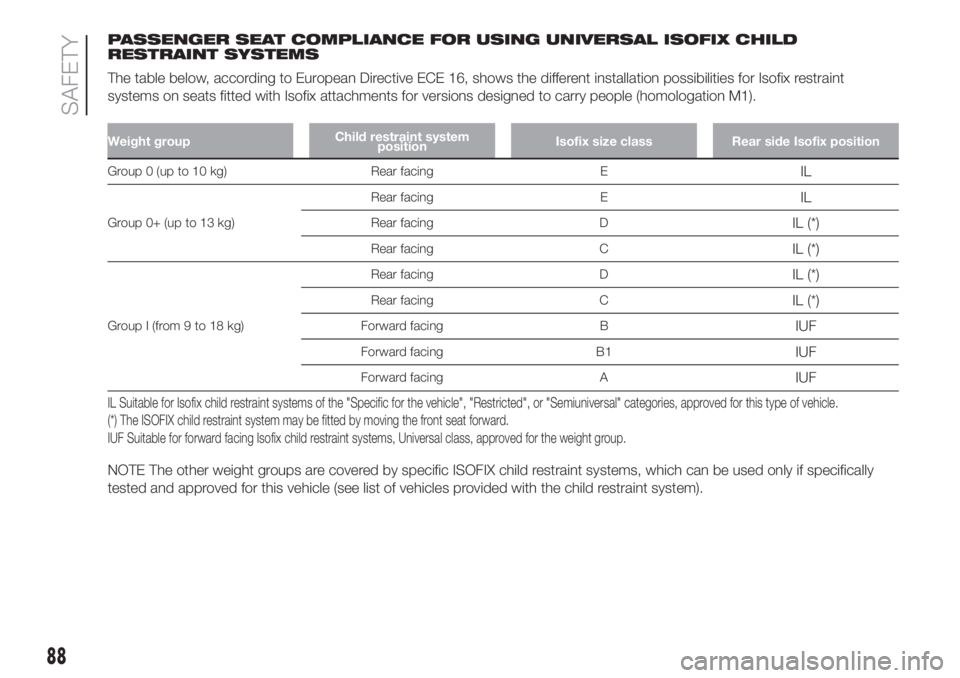
PASSENGER SEAT COMPLIANCE FOR USING UNIVERSAL ISOFIX CHILD
RESTRAINT SYSTEMS
The table below, according to European Directive ECE 16, shows the different installation possibilities for Isofix restraint
systems on seats fitted with Isofix attachments for versions designed to carry people (homologation M1).
Weight groupChild restraint system
positionIsofix size class Rear side Isofix position
Group 0 (up to 10 kg) Rear facing EIL
Group 0+ (up to 13 kg)Rear facing E
IL
Rear facing DIL (*)
Rear facing CIL (*)
Group I (from 9 to 18 kg)Rear facing D
IL (*)
Rear facing CIL (*)
Forward facing BIUF
Forward facing B1IUF
Forward facing AIUF
IL Suitable for Isofix child restraint systems of the "Specific for the vehicle", "Restricted", or "Semiuniversal" categories, approved for this type of vehicle.
(*) The ISOFIX child restraint system may be fitted by moving the front seat forward.
IUF Suitable for forward facing Isofix child restraint systems, Universal class, approved for the weight group.
NOTE The other weight groups are covered by specific ISOFIX child restraint systems, which can be used only if specifically
tested and approved for this vehicle (see list of vehicles provided with the child restraint system).
88
SAFETY
Page 91 of 220
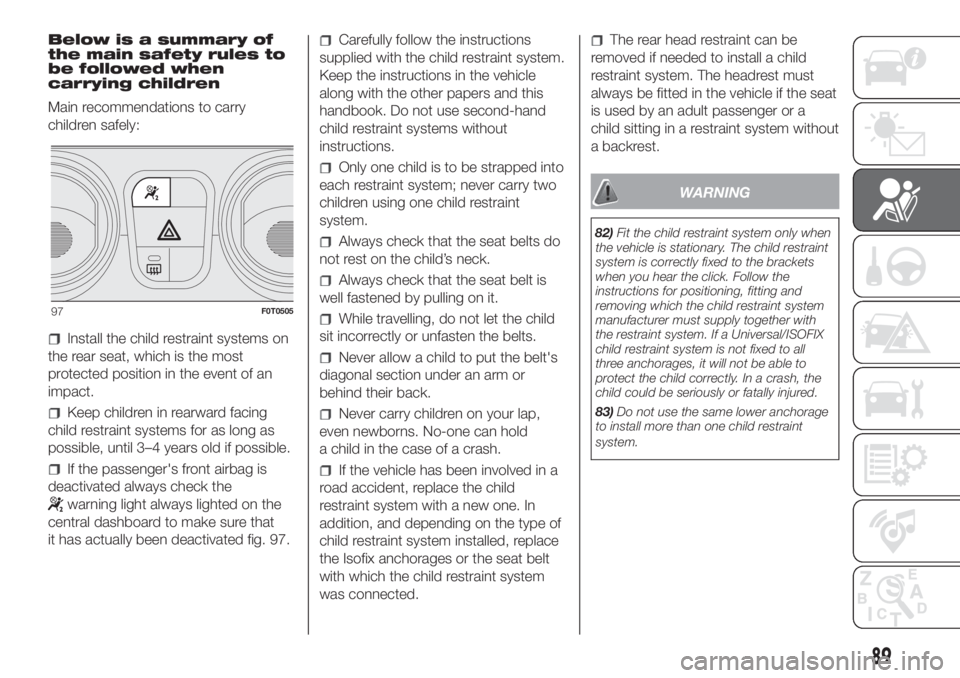
Below is a summary of
the main safety rules to
be followed when
carrying children
Main recommendations to carry
children safely:
Install the child restraint systems on
the rear seat, which is the most
protected position in the event of an
impact.
Keep children in rearward facing
child restraint systems for as long as
possible, until 3–4 years old if possible.
If the passenger's front airbag is
deactivated always check the
warning light always lighted on the
central dashboard to make sure that
it has actually been deactivated fig. 97.
Carefully follow the instructions
supplied with the child restraint system.
Keep the instructions in the vehicle
along with the other papers and this
handbook. Do not use second-hand
child restraint systems without
instructions.
Only one child is to be strapped into
each restraint system; never carry two
children using one child restraint
system.
Always check that the seat belts do
not rest on the child’s neck.
Always check that the seat belt is
well fastened by pulling on it.
While travelling, do not let the child
sit incorrectly or unfasten the belts.
Never allow a child to put the belt's
diagonal section under an arm or
behind their back.
Never carry children on your lap,
even newborns. No-one can hold
a child in the case of a crash.
If the vehicle has been involved in a
road accident, replace the child
restraint system with a new one. In
addition, and depending on the type of
child restraint system installed, replace
the Isofix anchorages or the seat belt
with which the child restraint system
was connected.
The rear head restraint can be
removed if needed to install a child
restraint system. The headrest must
always be fitted in the vehicle if the seat
is used by an adult passenger or a
child sitting in a restraint system without
a backrest.
WARNING
82)Fit the child restraint system only when
the vehicle is stationary. The child restraint
system is correctly fixed to the brackets
when you hear the click. Follow the
instructions for positioning, fitting and
removing which the child restraint system
manufacturer must supply together with
the restraint system. If a Universal/ISOFIX
child restraint system is not fixed to all
three anchorages, it will not be able to
protect the child correctly. In a crash, the
child could be seriously or fatally injured.
83)Do not use the same lower anchorage
to install more than one child restraint
system.
97F0T0505
89
Page 93 of 220
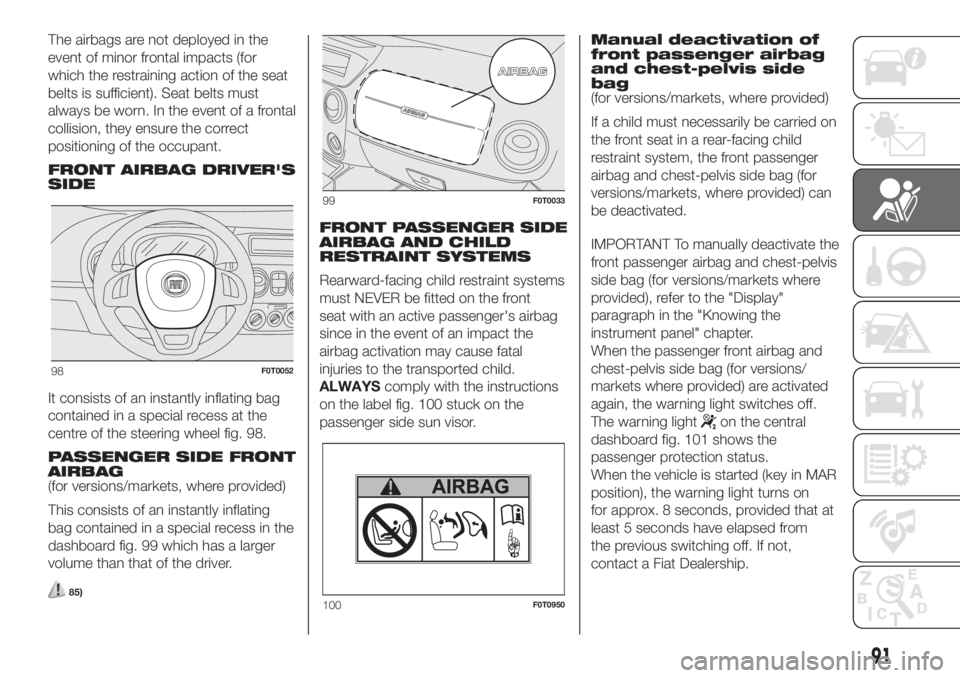
The airbags are not deployed in the
event of minor frontal impacts (for
which the restraining action of the seat
belts is sufficient). Seat belts must
always be worn. In the event of a frontal
collision, they ensure the correct
positioning of the occupant.
FRONT AIRBAG DRIVER'S
SIDE
It consists of an instantly inflating bag
contained in a special recess at the
centre of the steering wheel fig. 98.
PASSENGER SIDE FRONT
AIRBAG
(for versions/markets, where provided)
This consists of an instantly inflating
bag contained in a special recess in the
dashboard fig. 99 which has a larger
volume than that of the driver.
85)
FRONT PASSENGER SIDE
AIRBAG AND CHILD
RESTRAINT SYSTEMS
Rearward-facing child restraint systems
must NEVER be fitted on the front
seat with an active passenger's airbag
since in the event of an impact the
airbag activation may cause fatal
injuries to the transported child.
ALWAYScomply with the instructions
on the label fig. 100 stuck on the
passenger side sun visor.Manual deactivation of
front passenger airbag
and chest-pelvis side
bag
(for versions/markets, where provided)
If a child must necessarily be carried on
the front seat in a rear-facing child
restraint system, the front passenger
airbag and chest-pelvis side bag (for
versions/markets, where provided) can
be deactivated.
IMPORTANT To manually deactivate the
front passenger airbag and chest-pelvis
side bag (for versions/markets where
provided), refer to the "Display"
paragraph in the "Knowing the
instrument panel" chapter.
When the passenger front airbag and
chest-pelvis side bag (for versions/
markets where provided) are activated
again, the warning light switches off.
The warning light
on the central
dashboard fig. 101 shows the
passenger protection status.
When the vehicle is started (key in MAR
position), the warning light turns on
for approx. 8 seconds, provided that at
least 5 seconds have elapsed from
the previous switching off. If not,
contact a Fiat Dealership.
98F0T0052
99F0T0033
100F0T0950
91